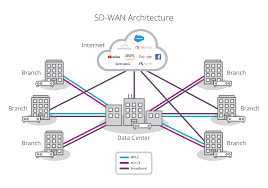SD-WAN, short for “software-defined WAN,” is a new generation of WAN network architecture that decouples network configuration and management from the transport medium. As a result, the technology improves application performance, provides MPLS-level QoS, and reduces capital costs. The following sections describe how SD-WAN works.
SD-WAN Is A Software Overlay That Decouples Wan Configuration
SD-WAN is a popular solution for businesses that need to access data centers and cloud resources. Its popularity is rising rapidly and will continue to grow as enterprises increase the size of their private data centers and adopt public cloud services.
Compared to other WAN options, SD-WAN systems are designed to be simple to manage. Rather than requiring a dedicated infrastructure and WAN manager, SD-WAN can provide all the services needed in one centralized console. This helps IT teams manage traffic and configure devices in one location. It also increases the visibility of the entire network.
In addition to simplifying the management and configuration of a WAN, SD-WAN also supports link aggregation and load balancing capabilities. Appliance-based solutions use virtual or physical appliances to create an overlay. They can be implemented by an organization or offered by service providers.
It Improves Application Performance.
An SD-WAN network improves application performance by providing multiple transport channels for different data types. This approach enables organizations to reduce the number of routes, thus increasing overall performance. The system is based on a policy-based data management model. This enables the network administrator to control traffic easily and avoid reconfiguring routers. It also allows the data control engineer to perform routine network maintenance and service checks from their office.
Poor performance of applications can be a significant deterrent to productivity.
It Provides MPLS-level QoS.
An SD-WAN over the Internet offers greater control over traffic and more precise QoS than an MPLS VPN. It can detect when performance is deteriorating and reroute traffic accordingly. Some vendors provide Forward Error Correction (FEC). Unlike MPLS, SD-WAN over the Internet can be configured dynamically, which is essential for Enterprises.
An SD-WAN network also supports multiple types of underlying connections. Its control plane abstracts the underlying hardware, allowing for streamlined provisioning and failover. This also provides significant operational flexibility. The network also offers advanced application visibility, security, and performance monitoring. This gives it a competitive edge over other WAN solutions.
It Reduces Capital Costs.
Using SD-WAN technology to manage and configure your network can help reduce capital costs while improving application performance. This flexible network technology can be used across multiple paths, including WAN and multi-cloud connectivity. This network can also protect your organization from malware and other threats.
An SD-WAN implementation can reduce the number of dedicated lines that your organization requires. Instead of purchasing multiple lines, you can replace them with one line, saving up to 60% of your current bandwidth needs. This can significantly cut down on capital costs. For example, a company with 200 branch offices would require two dedicated MPLS lines per location, costing the business $675 a month per office. Implementing an SD-WAN can reduce this cost to a single high-speed Internet bandwidth line. These savings add up to $120,000 per month.
It Enables Centralized Orchestration.
SD-WAN orchestration can provide many benefits to organizations. This technology allows businesses to apply consistent policies and configurations across all network locations, reducing performance and security issues. In addition, central orchestration allows for enhanced network performance visibility and can help diagnose problems more effectively. It can also help achieve high network security levels through tunneling and end-to-end encryption. These capabilities are critical to a successful SD-WAN deployment.
In short, according to the Not Responding – Can I Stream Netflix With 3G to get started, organizations should define their needs and requirements before deciding on the right SD-WAN network. Netflix Tv should define the type of connectivity they need and how it will be managed. They should also consider security features, including VPN and advanced cyber threat protection.

